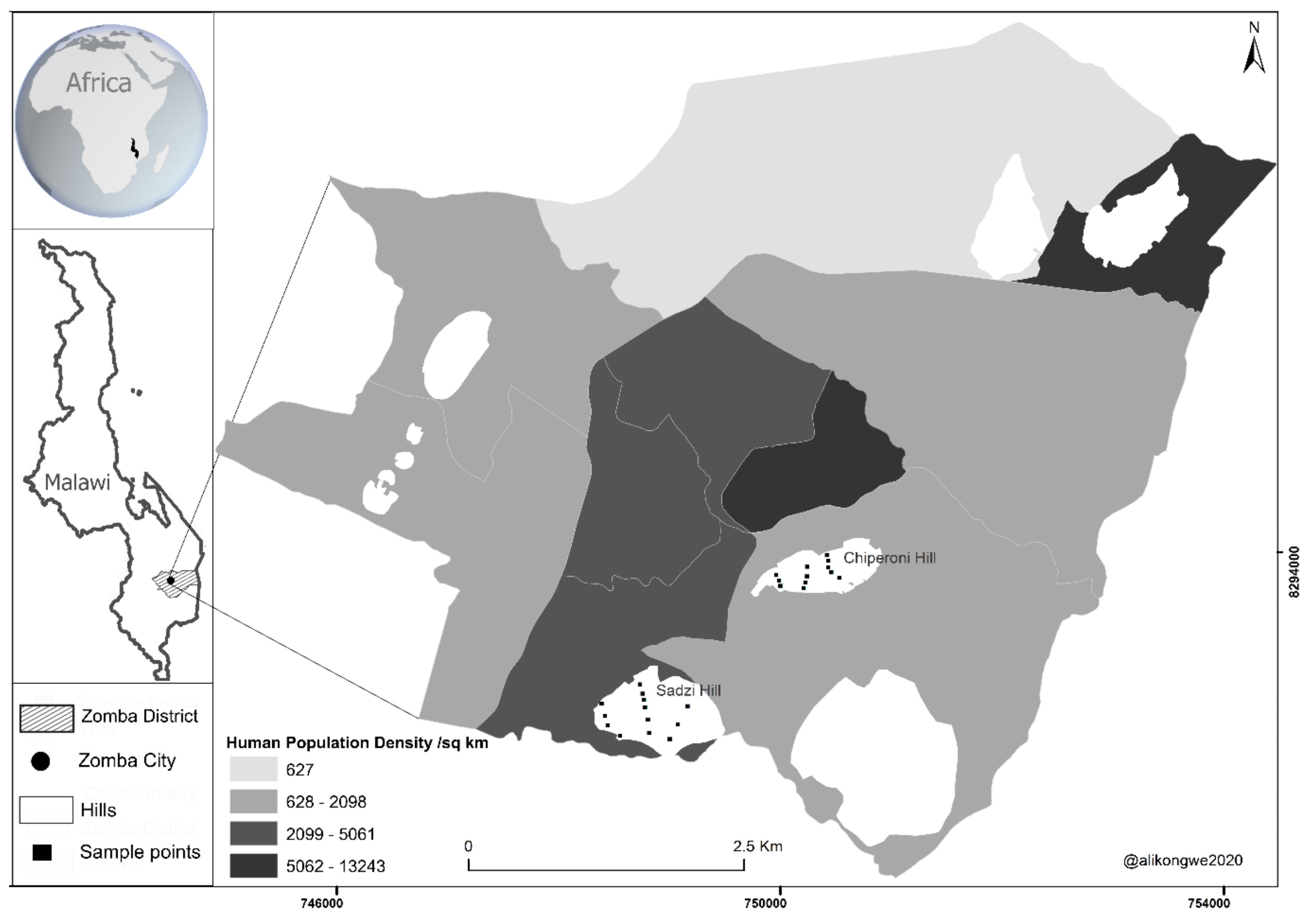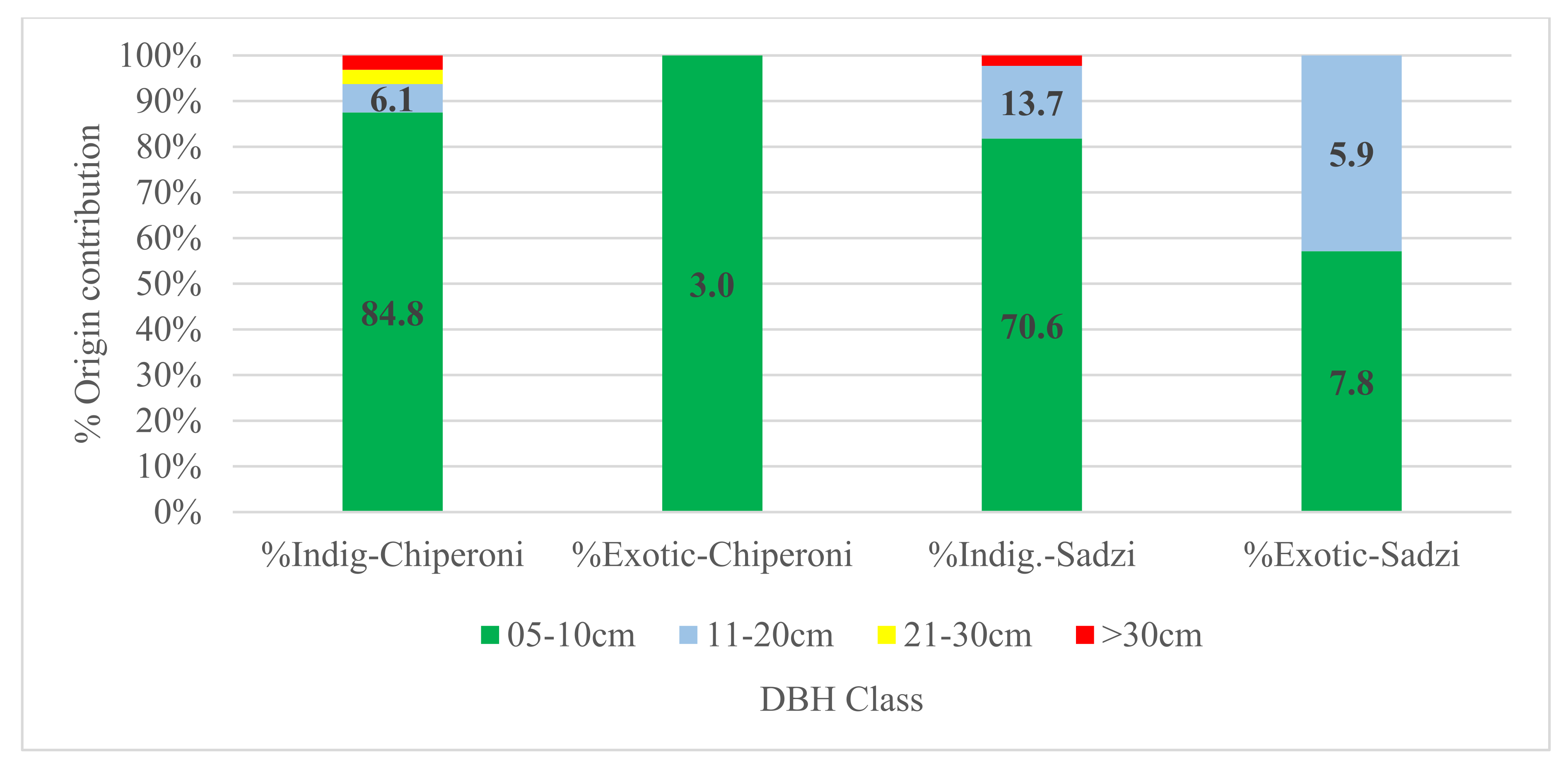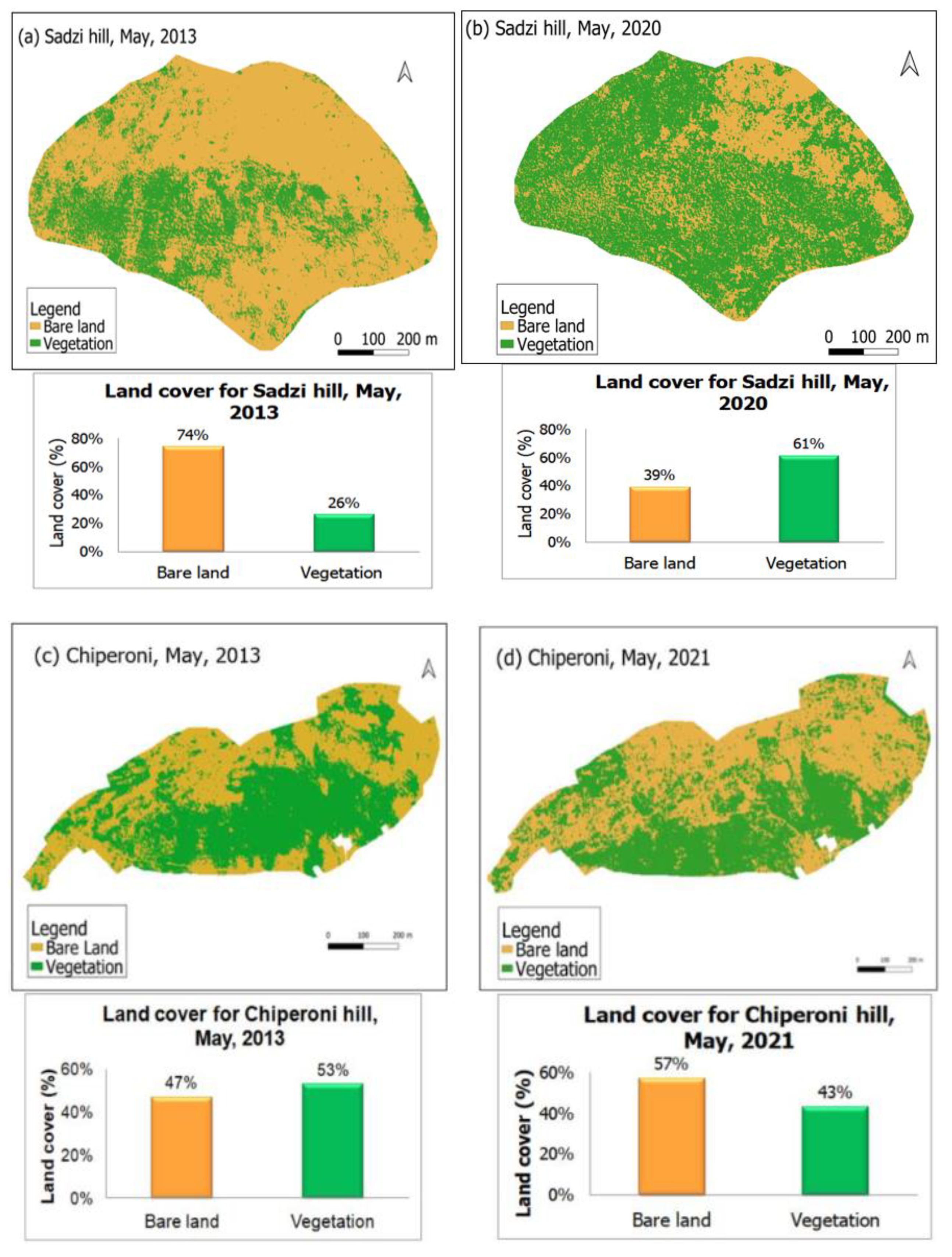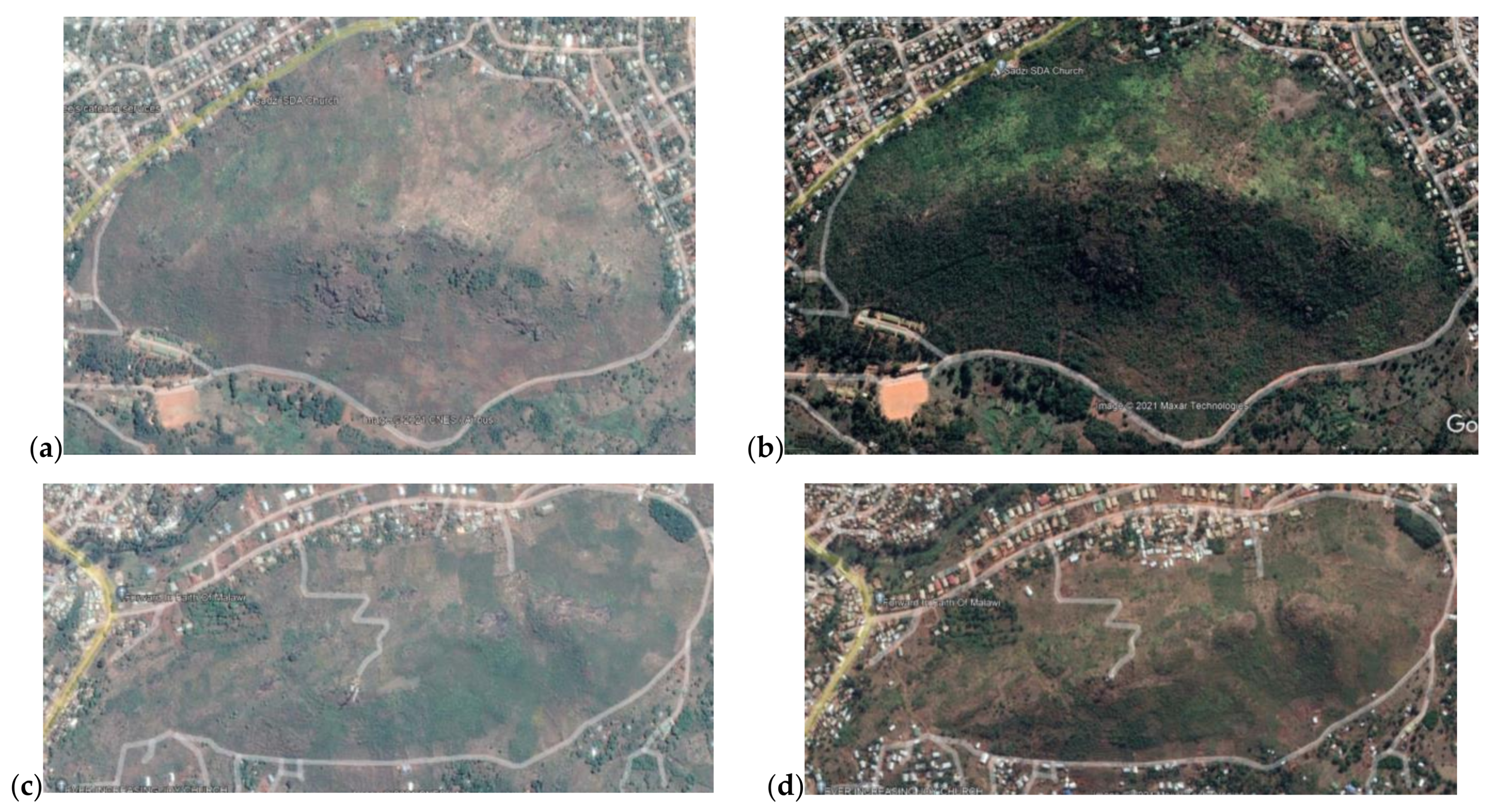Urban Community Power: Enhancing Urban Forest Diversity and Reversing Ecosystem Disservices in Zomba City, Malawi
Abstract
:1. Introduction
2. Materials and Methods
2.1. Study Site
2.2. Data Collection
2.3. Computation of Growth Parameters and Biodiversity Indices
2.4. Data Analysis
3. Results
3.1. Tree Species Composition and Structure
3.2. Growth Parameters, Biodiversity Indices and Importance Value Index
3.3. Spatial–Temporal Vegetation Cover Changes
3.4. Impact of Community Management on Vegetation Cover Changes
‘I am very happy with the restoration from the hill as three years now, I have had no problems with muddy waters running from the hill through my house, rainy seasons were a nightmare but that is now history’.Sadzi community member
‘Our vision is to continuously restore the hill and allow all other wild animals that are meant to stay in this hill to stay as they were created to be in this area but we chased them off due to our actions’.Chairperson from Sadzi Hill Community Management Group
‘With the group duly elected, a constitution and by-laws were crafted to aid in managing the hill and now efforts are towards production of a management plan where the hill will be categorized in line with the core functions it is providing like tourism and hiking routes, conservation area, bee keeping area, provisioning area for harvesting poles, and other things as agreed by all relevant stakeholders’.Forest Extension Officer, Zomba Forestry Department
‘Sadzi hill is a shining example in Zomba city and augers well with our vision for ‘A green and clean city’, with plans for a hiking trail, a recreation center, tourism hotspot, and environmental education center’.Mayor, Zomba City Council
4. Discussion
4.1. Tree Species Composition and Diversity Index
4.2. Growth Parameters, Biodiversity Index and Importance Value Index
4.3. Vegetation Cover Changes and Impact of Community Management Efforts on Restoration
5. Conclusions
Author Contributions
Funding
Acknowledgments
Conflicts of Interest
Appendix A
| Family | Tree Species | Chiperoni | Sadzi | Total Abundance |
|---|---|---|---|---|
| Anacardiaceae | Lannea discolour | 2 | 4 | 6 |
| Rhus longipes | 3 | 3 | ||
| Rhus natalensis | 2 | 2 | ||
| Sclerocarya birrea | 1 | 1 | ||
| Annonaceae | Anonna senegalensis | 2 | 17 | 19 |
| Apiaceae | Steganotaenia araliacea | 1 | 1 | |
| Apocynaceae | Diplorhynchus condylocarpon | 11 | 28 | 39 |
| Holarrhena pubescens | 3 | 3 | ||
| Rauvolfia caffra | 3 | 3 | ||
| Araliaceae | Cussonia arborea | 6 | 11 | 17 |
| Asteraceae | Vernonia corolata | 1 | 1 | 2 |
| Bignoniaceae | Stereospermum kunthianum | 1 | 1 | 2 |
| Chrysobalanaceae | Parinari curatellifolia | 1 | 12 | 13 |
| Combretaceae | Combretum molle | 2 | 4 | 6 |
| Combretum zeyheri | 2 | 2 | ||
| Pteleopsis myritifolia | 7 | 7 | ||
| Terminalia sericea | 1 | 2 | 3 | |
| Fabaceae | Acacia gerrardii | 5 | 5 | |
| Afzelia quanzensis | 1 | 3 | 4 | |
| Albizia antunesiana | 1 | 1 | 2 | |
| Albizia versicolor | 6 | 6 | ||
| Bauhinia petersiana | 5 | 19 | 24 | |
| Bobgunnia madagascariensis | 7 | 7 | ||
| Brachystegia boehmii | 1 | 1 | ||
| Brachystegia bussei | 18 | 18 | ||
| Brachystegia longifolia | 1 | 3 | 4 | |
| Brachystegia spiciformis | 2 | 2 | ||
| Brachystegia utilis | 1 | 6 | 7 | |
| Dalbergia boehmii | 2 | 47 | 49 | |
| Dalbergia melanoxylon | 2 | 2 | ||
| Dalbergia nitidula | 2 | 4 | 6 | |
| Dalbergiella nyasae | 1 | 1 | ||
| Julbernardia globiflora | 11 | 8 | 19 | |
| Pericopsis angolensis | 8 | 8 | ||
| Piliostigma thonningii | 5 | 5 | ||
| Pterocarpus angolensis | 8 | 17 | 25 | |
| * Senna siamea | 5 | 5 | ||
| Lamiaceae | * Gmelina arborea | 20 | 20 | |
| Vitex doniana | 8 | 8 | ||
| Loganiaceae | Strychnos innocua | 7 | 7 | |
| Strychnos spinose | 5 | 5 | ||
| Malvaceae | Dombeya rotundifolia | 1 | 1 | |
| Grewia micrantha | 1 | 1 | ||
| Meliaceae | * Toona ciliata | 7 | 7 | |
| Myrtaceae | * Eucalyptus camaldulensis | 5 | 5 | |
| * Eucalyptus saligna | 29 | 29 | ||
| Phyllanthaceae | Bridelia micrantha | 2 | 2 | |
| Margaritaria discoidea | 14 | 14 | ||
| Pseudolachnostylis maprouneifolia | 1 | 9 | 10 | |
| Uapaca kirkiana | 4 | 4 | ||
| Sapindaceae | Allophyllus africanus | 1 | 1 |
References
- Gairola, S.; Noresah, M.S. Emerging trend of urban green space research and the implications for safeguarding biodiversity: A viewpoint. Nat. Sci. 2010, 8, 43–49. [Google Scholar]
- World Health Organization, Regional Office for Europe. Urban Green Spaces: A Brief for Action; World Health Organization, Regional Office for Europe: Copenhagen, Denmark, 2017. [Google Scholar]
- Titz, A.; Chiotha, S.S. Pathways for Sustainable and Inclusive Cities in Southern and Eastern Africa through Urban Green Infrastructure? Sustainability 2019, 11, 2729. [Google Scholar] [CrossRef] [Green Version]
- Haines-Young, R.; Potschin, M. Guidance on the Application of the Revised Structure. 2018, p. 53. Available online: https://cices.eu/content/uploads/sites/8/2018/01/Guidance-V51-01012018.pdf (accessed on 16 September 2021).
- Jim, C.Y.; Chen, W.Y. Recreation–amenity use and contingent valuation of urban greenspaces in Guangzhou, China. Landsc. Urban Plan. 2006, 75, 81–96. [Google Scholar] [CrossRef]
- O’Brien, L.; De Vreese, R.; Kern, M.; Sievänen, T.; Stojanova, B.; Atmiş, E. Cultural ecosystem benefits of urban and peri-urban green infrastructure across different European countries. Urban For. Urban Green. 2017, 24, 236–248. [Google Scholar] [CrossRef]
- Farhadi, H.; Faizi, M.; Sanaieian, H. Mitigating the urban heat island in a residential area in Tehran: Investigating the role of vegetation, materials, and orientation of buildings. Sustain. Cities Soc. 2019, 46, 101448. [Google Scholar] [CrossRef]
- Yao, L.; Chen, L.; Wei, W.; Sun, R. Potential reduction in urban runoff by green spaces in Beijing: A scenario analysis. Urban For. Urban Green. 2015, 14, 300–308. [Google Scholar] [CrossRef]
- Nowak, D.J.; Crane, D.E.; Stevens, J.C. Air pollution removal by urban trees and shrubs in the United States. Urban For. Urban Green. 2006, 4, 115–123. [Google Scholar] [CrossRef]
- Nowak, D.J.; Hirabayashi, S.; Bodine, A.; Hoehn, R. Modeled PM2.5 removal by trees in ten U.S. cities and associated health effects. Environ. Pollut. 2013, 178, 395–402. [Google Scholar] [CrossRef] [PubMed]
- Hernández, H.J.; Villaseñor, N.R. Twelve-year change in tree diversity and spatial segregation in the Mediterranean city of Santiago, Chile. Urban For. Urban Green. 2018, 29, 10–18. [Google Scholar] [CrossRef]
- Gong, C.; Yu, S.; Joesting, H.; Chen, J. Determining socioeconomic drivers of urban forest fragmentation with historical remote sensing images. Landsc. Urban Plan. 2013, 117, 57–65. [Google Scholar] [CrossRef]
- Mensah, C.A. Urban Green Spaces in Africa: Nature and Challenges. Int. J. Ecosyst. 2014, 4, 1–11. [Google Scholar]
- Murtala, D.; Manaf, L.A. Progress and Methodological Approaches in Urban Trees and Forests Research in Africa. J. Environ. Earth Sci. 2019, 9, 32. [Google Scholar]
- Gwedla, N.; Shackleton, C.M. Population size and development history determine street tree distribution and composition within and between Eastern Cape towns, South Africa. Urban For. Urban Green. 2017, 25, 11–18. [Google Scholar] [CrossRef]
- Adjei Mensah, C.; Andres, L.; Baidoo, P.; Eshun, J.K.; Antwi, K.B. Community Participation in Urban Planning: The Case of Managing Green Spaces in Kumasi, Ghana. Urban Forum 2017, 28, 125–141. [Google Scholar] [CrossRef]
- Azadi, H.; Ho, P.; Hafni, E.; Zarafshani, K.; Witlox, F. Multi-stakeholder involvement and urban green space performance. J. Environ. Plan. Manag. 2011, 54, 785–811. [Google Scholar] [CrossRef]
- Southern African Development Community: Show. Available online: https://www.sadc.int/documents-publications/show/SADC_Regional_Biodiversity_Strategy.pdf (accessed on 16 September 2021).
- Johnston, M.; Shimada, L. Urban forestry in a multicultural society. J. Arboric. 2004, 30, 185–192. [Google Scholar]
- Mahjabeen, Z.; Shrestha, K.K.; Dee, J.A. Rethinking Community Participation in Urban Planning: The Role of Disadvantaged Groups in Sydney Metropolitan Strategy. Australas. J. Reg. Stud. 2009, 15, 45–63. [Google Scholar]
- Mattijssen, T.J.M.; van der Jagt, A.; Buijs, A.; Elands, B.; Erlwein, S.; Lafortezza, R. The long-term prospects of citizens managing urban green space: From place making to place-keeping? Urban For. Urban Green. 2017, 26, 78–84. [Google Scholar] [CrossRef]
- Mattijssen, T.; Buijs, A.; Elands, B. The benefits of self-governance for nature conservation: A study on active citizenship in the Netherlands. J. Nat. Conserv. 2018, 43, 19–26. [Google Scholar] [CrossRef]
- Vargas-Hernández, J.G.; Pallagst, K.; ZdunekWielgołaska, J. Urban green spaces as a component of an ecosystem: Functions, services, users, community involvement, initiatives and actions. Rev. Urban. 2017, 37, 1–26. [Google Scholar] [CrossRef]
- Wamsler, C.; Alkan-Olsson, J.; Björn, H.; Falck, H.; Hanson, H.; Oskarsson, T.; Simonsson, E.; Zelmerlow, F. Beyond participation: When citizen engagement leads to undesirable outcomes for nature-based solutions and climate change adaptation. Clim. Chang. 2020, 158, 235–254. [Google Scholar] [CrossRef] [Green Version]
- du Toit, M.J.; Cilliers, S.S.; Dallimer, M.; Goddard, M.; Guenat, S.; Cornelius, S.F. Urban green infrastructure and ecosystem services in sub-Saharan Africa. Landsc. Urban Plan. 2018, 180, 249–261. [Google Scholar] [CrossRef]
- Chimaimba, F.B.; Kafumbata, D.; Chanyenga, T.; Chiotha, S. Urban tree species composition and diversity in Zomba city, Malawi: Does land use type matter? Urban For. Urban Green. 2020, 54, 126781. [Google Scholar] [CrossRef]
- Oksanen, J.; Blanchet, F.G.; Kindt, R.; Legendre, P.; Minchin, P.R.; O’Hara, R.B.; Simpson, G.L.; Solymos, P.; Henry, M.; Stevens, M.H.H.; et al. Vegan: Community Ecology Package. R Package Version 2.2–1.2. 2012. [Google Scholar]
- Agbelade, A.D.; Onyekwelu, J.; Apogbona, O. Assessment of Urban Forest Tree Species Population and Diversity in Ibadan, Nigeria. Environ. Ecol. 2016, 4, 185–192. [Google Scholar] [CrossRef]
- Agbelade, A. Tree Species Diversity and their Benefits in Urban and Peri-Urban Areas of Abuja and Minna, Nigeria. Appl. Trop. Agric. 2016, 21, 27–36. [Google Scholar]
- Kacholi, D.S. Analysis of Structure and Diversity of the Kilengwe Forest in the Morogoro Region, Tanzania. Int. J. Biodivers. 2014, 2014, e516840. [Google Scholar] [CrossRef] [Green Version]
- Gentry, A.H. Changes in Plant Community Diversity and Floristic Composition on Environmental and Geographical Gradients. Ann. Mo. Bot. Gard. 1988, 75, 1–34. [Google Scholar] [CrossRef]
- Valencia, R.; Balslev, H.; Paz YMiño, C. High tree alpha-diversity in Amazonian Ecuador. Biodivers. Conserv. 1994, 3, 21–28. [Google Scholar] [CrossRef]
- Addo-Fordjour, P.; Obeng, S.; Anning, A.K.; Addo, M.G. Floristic Composition, Structure and Natural Regeneration in a Moist Semi-Deciduous Forest Following Anthropogenic Disturbances and Plant Invasion. Available online: https://restoration.elti.yale.edu/resource/floristic-composition-structure-and-natural-regeneration-moist-semi-deciduous-forest (accessed on 16 September 2021).
- Kacholi, D.S.; Whitbread, A.M.; Worbes, M. Diversity, abundance, and structure of tree communities in the Uluguru forests in the Morogoro region, Tanzania. J. For. Res. 2015, 26, 557–569. [Google Scholar] [CrossRef]
- Burgess, N.D.; Clarke, G.P. Coastal forests of eastern Africa. Coast. For. East. Afr. 2000, 64, 337–367. [Google Scholar]
- Table_4_5—Protected Tree Species in Malawi. Available online: http://www.sdnp.org.mw/enviro/action_plan/table_4_5.html (accessed on 17 September 2021).
- Chao, A.; Chazdon, R.L.; Colwell, R.K.; Shen, T.-J. Abundance-based similarity indices and their estimation when there are unseen species in samples. Biometrics 2006, 62, 361–371. [Google Scholar] [CrossRef] [PubMed]
- Dhyani, S.; Singh, A.; Gujre, N.; Joshi, R.K. Quantifying tree carbon stock in historically conserved Seminary Hills urban forest of Nagpur, India. Acta Ecol. Sin. 2021, 41, 193–203. [Google Scholar] [CrossRef]
- Dangulla, M.; Abd Manaf, L.; Ramli, M.F.; Yacob, M.R. Urban tree composition, diversity and structural characteristics in North-western Nigeria. Urban For. Urban Green. 2020, 48, 126512. [Google Scholar] [CrossRef]
- Mckinney, M. Effects of urbanization on species richness: A review of plants and animals. Urban Ecosyst. 2008, 11, 161–176. [Google Scholar] [CrossRef]
- Sarkar, M.; Devi, A. Assessment of diversity, population structure and regeneration status of tree species in Hollongapar Gibbon Wildlife Sanctuary, Assam, Northeast India. Trop. Plant Res. 2014, 1, 26–36. [Google Scholar]
- Gopal, D.; Nagendra, H.; Manthey, M. Vegetation in Bangalore’s Slums: Composition, Species Distribution, Density, Diversity, and History. Environ. Manag. 2015, 55, 1390–1401. [Google Scholar] [CrossRef] [PubMed]
- Kacholi, D.S. Effects of Habitat Fragmentation on Biodiversity of Uluguru Mountain Forests in Morogoro Region, Tanzania; Cuvillier Verlag: Göttingen, Germany, 2013; Available online: https://cuvillier.de/uploads/preview/public_file/7914/Leseprobe.pdf (accessed on 16 September 2021).
- Kacholi, D.S. Assessment of Tree Species Richness, Diversity, Population Structure and Natural Regeneration in Nongeni Forest Reserve in Morogoro Region, Tanzania. Tanzan. J. Sci. 2019, 45, 330–345. [Google Scholar]
- Useni Sikuzani, Y.; Malaisse, F.; Kaleba, S.C.; Mwanke, A.K.; Yamba, A.M.; Khonde, C.N.; Bogaert, J.; Kankumbi, F.M. Tree diversity and structure on green space of urban and peri-urban zones: The case of Lubumbashi City in the Democratic Republic of Congo. Urban For. Urban Green. 2019, 41, 67–74. [Google Scholar] [CrossRef]
- National Biodiversity Strategy and Action Plan II 2015–2025. Available online: https://cepa.org.mw/Library/government-publications/national-biodiversity-strategy-and-action-plan-ii-2015-2025 (accessed on 17 September 2021).
- Hobbie, S.E.; Grimm, N.B. Nature-based approaches to managing climate change impacts in cities. Philos. Trans. R. Soc. B Biol. Sci. 2020, 375, 20190124. [Google Scholar] [CrossRef] [Green Version]
- Millennium Ecosystem Assessment. Ecosystems and Human Well-Being: Health Synthesis. 2005. Available online: https://www.who.int/publications-detail-redirect/ecosystems-and-human-well-being-health-synthesis. (accessed on 16 September 2021).
- Benedict, M.A.; McMahon, E. Green Infrastructure: Linking Landscapes and Communities; Island Press: Washington, DC, USA, 2006. [Google Scholar]
- Hansen, R.; Pauleit, S. From multifunctionality to multiple ecosystem services? A conceptual framework for multifunctionality in green infrastructure planning for urban areas. Ambio 2014, 43, 516–529. [Google Scholar] [CrossRef] [PubMed] [Green Version]
- Garekae, H.; Shackleton, C.M. Urban foraging of wild plants in two medium-sized South African towns: People, perceptions and practices. Urban For. Urban Green. 2020, 49, 126581. [Google Scholar] [CrossRef]
- Shackleton, C.M.; Ruwanza, S.; Sanni, G.S.; Bennett, S.; De Lacy, P.; Modipa, R.; Mtati, N.; Sachikonye, M.; Thondhlana, G. Unpacking Pandora’s Box: Understanding and Categorising Ecosystem Disservices for Environmental Management and Human Wellbeing. Ecosystems 2016, 19, 587–600. [Google Scholar] [CrossRef]
- Lyytimäki, J.; Sipilä, M. Hopping on one leg—The challenge of ecosystem disservices for urban green management. Urban For. Urban Green. 2009, 8, 309–315. [Google Scholar] [CrossRef]
- Lyytimäki, J. Ecosystem disservices: Embrace the catchword. Ecosyst. Serv. 2015, 12, 136. [Google Scholar] [CrossRef]
- Azmy, M.M.; Hosaka, T.; Numata, S. Responses of four hornet species to levels of urban greenness in Nagoya city, Japan: Implications for ecosystem disservices of urban green spaces. Urban For. Urban Green. 2016, 18, 117–125. [Google Scholar] [CrossRef]
- United Nations. Sustainable Development Goals|United Nations Development Programme. 2015. Available online: https://www.undp.org/sustainable-development-goals?utm_source=EN&utm_medium=GSR&utm_content=US_UNDP_PaidSearch_Brand_English&utm_campaign=CENTRAL&c_src=CENTRAL&c_src2=GSR&gclid=Cj0KCQjw1ouKBhC5ARIsAHXNMI-PaZFhOCglUMtogq9K7CISLgfc6JnIIQRpW7AohYzzqWDySYIPnpEaAjVnEALw_wcB (accessed on 16 September 2021).
- Shackleton, C.M.; Njwaxu, A. Does the absence of community involvement underpin the demise of urban neighbourhood parks in the Eastern Cape, South Africa? Landsc. Urban Plan. 2021, 207, 104006. [Google Scholar] [CrossRef]
- Charles, A.; Loucks, L.; Berkes, F.; Armitage, D. Community science: A typology and its implications for governance of social-ecological systems. Environ. Sci. Policy 2020, 106, 77–86. [Google Scholar] [CrossRef]
- Chishaleshale, M.; Shackleton, C.M.; Gambiza, J.; Gumbo, D. The prevalence of planning and management frameworks for trees and green spaces in urban areas of South Africa. Urban For. Urban Green. 2015, 14, 817–825. [Google Scholar] [CrossRef]





| Key Informant | Number | Why Selected |
|---|---|---|
| Parks and recreation department | 1 | The department oversees all green spaces in the city including the hills |
| Non-governmental organization (NGO) | 1 | NGO had extensive work experience with the two hills |
| City council | 2 | These represented the administrative and political leaders of the city |
| Forest department | 1 | The department provides technical expertise on trees within the city |
| Conservation committee leaders | 2 | Leaders of the committees responsible for managing the hills |
| Community leaders | 2 | The green spaces (hills) are within their jurisdiction |
| Community members | 2 | To have a community perspective |
| Diversity Index | Equation | What for |
|---|---|---|
| Chao1 | Estimating potential for species richness in each hill | |
| Shannon–Wiener | Understanding current tree species abundance and richness—diversity | |
| Shannon’s Maximum Diversity | Maximum species diversity | |
| Shannon’s Equitability | Species evenness if different from the hills | |
| Bray–Curtis Dissimilarity | Checking species dissimilarity between the hills | |
| Importance Value Index | IVI = RF + RD + RDo | Aggregate species importance from each hill |
| Parameter | Chiperoni Hill | Sadzi Hill |
|---|---|---|
| Number of plots sampled | 12 | 13 |
| Number of trees sampled | 112 a | 333 b |
| Mean number of trees/plot | 9.75 a | 27.83 b |
| Maximum number of trees/plot | 29 a | 57 b |
| Estimated number of trees/ha | 244 a | 695 b |
| Percent indigenous tree counts | 95% | 82% |
| Percent indigenous tree species | 97% | 90% |
| Mean DBH (cm) | 6.64 a | 6.59 a |
| Maximum DBH (cm) | 22.0 a | 19.6 a |
| Maximum height (m) | 7.1 | 9.5 |
| Number of tree species | 32 a | 42 b |
| Number of genera | 25 a | 34 b |
| Number of families | 13 a | 16 a |
| Statistic | Chiperoni Hill | Sadzi Hill |
|---|---|---|
| Chao1 (Sest) | 380 | 292 |
| Shannon–Wiener diversity index (H′) | 3.03 | 3.20 |
| Maximum diversity index (Hmax) | 3.50 | 3.80 |
| Shannon’s equitability index (EH) | 0.89 | 0.86 |
| Bray–Curtis dissimilarity (BCij) | 75.7% | |
| No. | Family | Species | RF | RD | RDo | IVI |
|---|---|---|---|---|---|---|
| 1 | Apocynaceae | Diplorhynchus condylocarpon | 13.73 | 9.82 | 13.15 | 36.70 |
| 2 | Phyllanthaceae | Margaritaria discoidea | 1.96 | 12.50 | 19.80 | 34.26 |
| Uapaca kirkiana | 1.96 | 0.89 | 6.56 | 9.41 | ||
| 3 | Fabaceae | Julbernardia globiflora | 11.76 | 9.82 | 11.09 | 32.68 |
| Pterocarpus angolensis | 9.80 | 7.14 | 6.64 | 23.59 | ||
| 4 | Loganiacea | Strychnos innocua | 1.96 | 6.25 | 17.93 | 26.14 |
| Strychnos spinose | 3.92 | 4.46 | 2.08 | 10.47 | ||
| 5 | Araliaceae | Cussonia arborea | 7.84 | 5.36 | 4.63 | 17.83 |
| 6 | Combretaceae | Pteleopsis myritifolia | 1.96 | 6.25 | 4.31 | 12.52 |
| 7 | Myrtaceae | * Eucalyptus camaldulensis | 3.92 | 4.46 | 2.73 | 11.11 |
| Total | 58.82 | 66.96 | 88.94 | 214.73 |
| No. | Family | Species | RF | RD | RDo | IVI |
|---|---|---|---|---|---|---|
| 1 | Fabaceae | Dalbergia boehmii | 2.94 | 14.11 | 33.27 | 50.33 |
| Bauhinia petersiana | 4.90 | 5.71 | 4.47 | 15.08 | ||
| Pterocarpus angolensis | 4.90 | 5.10 | 3.95 | 13.96 | ||
| Brachystegia bussei | 3.92 | 5.40 | 4.06 | 13.38 | ||
| 2 | Myrtaceae | * Eucalyptus saligna | 7.84 | 8.71 | 11.99 | 28.54 |
| 3 | Apocynaceae | Diplorhynchus condylocarpon | 4.90 | 8.41 | 13.62 | 26.93 |
| 4 | Lamiaceae | * Gmelina arborea | 2.94 | 6.01 | 8.45 | 17.39 |
| 5 | Annonaceae | Anonna senegalensis | 7.84 | 5.10 | 3.69 | 16.64 |
| 6 | Araliaceae | Cussonia arborea | 4.90 | 3.30 | 3.00 | 11.20 |
| 7 | Chrysobalanaceae | Parinari curatellifolia | 3.92 | 3.60 | 2.03 | 9.56 |
| Total | 49.02 | 65.46 | 88.53 | 203.02 |
| No. | Family | RF | RD | RDo | FIVI |
|---|---|---|---|---|---|
| 1 | Fabaceae | 20.00 | 45.05 | 31.88 | 96.33 |
| 2 | Phyllanthaceae | 7.62 | 7.21 | 22.48 | 37.31 |
| 3 | Apocynaceae | 12.38 | 10.14 | 9.32 | 31.84 |
| 4 | Myrtaceae | 9.52 | 7.66 | 5.73 | 22.91 |
| 5 | Araliaceae | 8.57 | 3.83 | 4.76 | 17.16 |
| 6 | Lamiaceae | 3.81 | 6.31 | 6.79 | 16.91 |
| 7 | Annonaceae | 8.57 | 4.28 | 2.70 | 15.55 |
| 8 | Combretaceae | 6.67 | 4.05 | 2.49 | 13.21 |
| 9 | Anacardiaceae | 5.71 | 2.70 | 253 | 10.94 |
| 10 | Loganiaceae | 2.86 | 2.70 | 5.11 | 10.67 |
| Total | 85.71 | 93.92 | 93.78 | 272.86 |
| Hill | Sadzi | Chiperoni |
|---|---|---|
| Provisioning | Wild fruits Medicinal plants Increased presence of trees that can be used for construction | Wild fruits Medicinal plants Fuel wood Building materials Crop cultivation for food |
| Regulating | Soil erosion prevention Wind break Temperature regulation Regulation of water flow and runoff Water purification Carbon storage Pollination | Carbon storage Pollination |
| Cultural | Esthetic beauty Spiritual connection Physical exercise Tourism possibilities | Physical exercise |
| Supporting | Home to more flora and fauna Maintenance of functional diversity | Home to flora and fauna |
| Before Restoration | Ecosystem Disservices |
|---|---|
| Sadzi Hill | Soil erosion from water and wind, mud and rock slides |
| Chiperoni Hill | Soil erosion, reduced biodiversity due to fires |
| After Seven Years | |
| Sadzi Hill | None reported currently |
| Chiperoni Hill | Increased soil erosion, increased biodiversity loss due to unsustainable harvesting of biomass and fires |
Publisher’s Note: MDPI stays neutral with regard to jurisdictional claims in published maps and institutional affiliations. |
© 2021 by the authors. Licensee MDPI, Basel, Switzerland. This article is an open access article distributed under the terms and conditions of the Creative Commons Attribution (CC BY) license (https://creativecommons.org/licenses/by/4.0/).
Share and Cite
Likongwe, P.J.; Chimaimba, F.B.; Chiotha, S.S.; Mandevu, T.; Kamuyango, L.; Garekae, H. Urban Community Power: Enhancing Urban Forest Diversity and Reversing Ecosystem Disservices in Zomba City, Malawi. Land 2021, 10, 1258. https://doi.org/10.3390/land10111258
Likongwe PJ, Chimaimba FB, Chiotha SS, Mandevu T, Kamuyango L, Garekae H. Urban Community Power: Enhancing Urban Forest Diversity and Reversing Ecosystem Disservices in Zomba City, Malawi. Land. 2021; 10(11):1258. https://doi.org/10.3390/land10111258
Chicago/Turabian StyleLikongwe, Patrick J., Frank B. Chimaimba, Sosten S. Chiotha, Treaser Mandevu, Lois Kamuyango, and Hesekia Garekae. 2021. "Urban Community Power: Enhancing Urban Forest Diversity and Reversing Ecosystem Disservices in Zomba City, Malawi" Land 10, no. 11: 1258. https://doi.org/10.3390/land10111258
APA StyleLikongwe, P. J., Chimaimba, F. B., Chiotha, S. S., Mandevu, T., Kamuyango, L., & Garekae, H. (2021). Urban Community Power: Enhancing Urban Forest Diversity and Reversing Ecosystem Disservices in Zomba City, Malawi. Land, 10(11), 1258. https://doi.org/10.3390/land10111258






